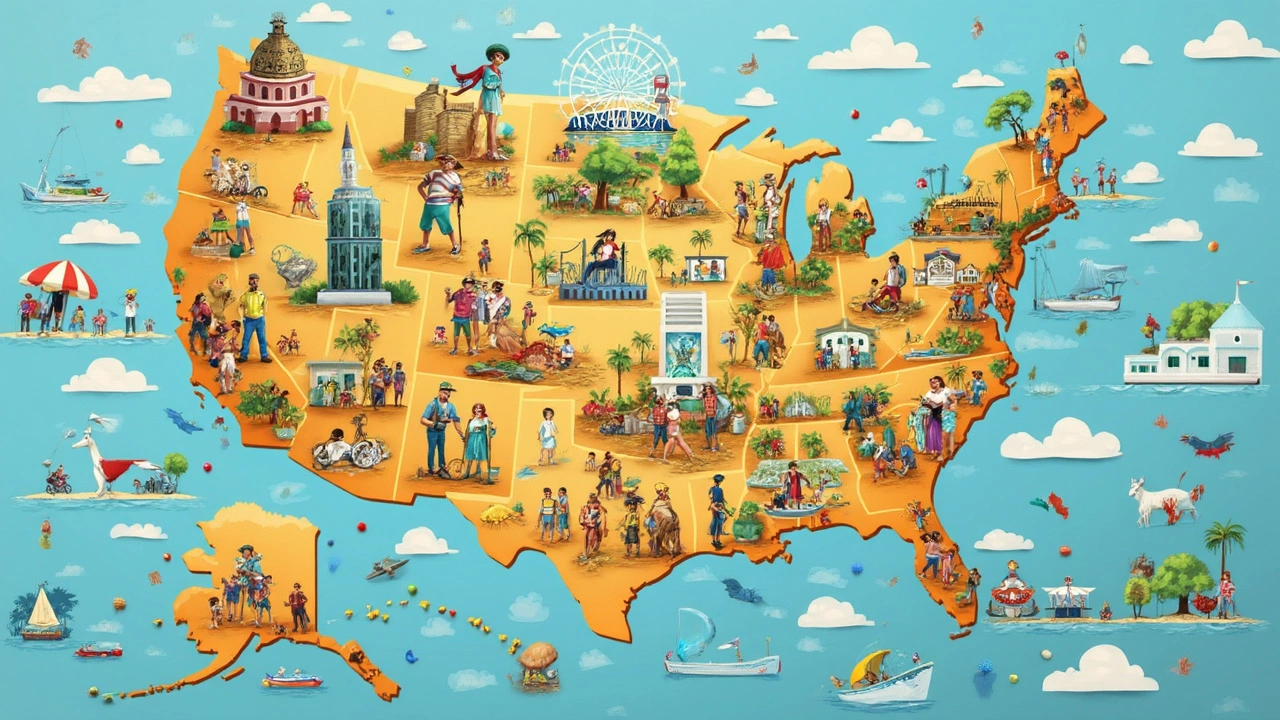Here's a question that might have crossed your mind while planning a sunny getaway: Why are all-inclusive hotels not really a thing in the US? It's a head-scratcher, especially when you think about how wildly popular they are in places like Mexico and the Caribbean. Let's unravel this curious case by exploring the history, culture, and some economic factors.
First off, all-inclusive resorts owe their fame to the exotic places where exploring beyond the hotel isn't always needed or easy. But Americans tend to vacation a bit differently. They love the idea of road trips, city hopping, and trying local eateries rather than staying put in one spot. It's less about staying at the hotel all day and more about the adventure outside it. This travel culture plays a big role in why the US hasn't widely adopted the all-inclusive trend.
- The History of All-Inclusive Resorts
- Cultural Preferences in US Travel
- The Economic Side of Hospitality
- Challenges of Implementing All-Inclusive in the US
- Alternatives and Future Trends
The History of All-Inclusive Resorts
The idea of all-inclusive hotels isn't as new as you might think. It all started in the 1950s when a Belgian by the name of Gérard Blitz opened the first Club Med village in Majorca, Spain. The concept was simple yet revolutionary: a holiday where everything is paid upfront, so you don't have to worry about the tab once you're there.
Back then, it was all about providing a place to escape from daily life without surprises, and this idea caught on like wildfire. By the 1970s, the all-inclusive resort model was dream fuel for vacationers who wanted sun, sea, and stress-free stays—especially in places like the Caribbean and Mexico.
Fast forward to the '80s and '90s, and these resorts became synonymous with tropical locales. Why? It comes down to a combination of lush settings, favorable exchange rates, and the promise of an easy getaway where everything's on tap—from meals to entertainment. This period also saw a boom in American travelers exploring Central America and the Caribbean, fueling further growth.
However, as much as these resorts were taking off internationally, the US market was a different beast. The unique travel culture in America didn't exactly groove with the all-inclusive vibe. While international destinations were focusing on consolidating guest experiences onsite, US hotels were still capitalizing on their rich surroundings, encouraging guests to explore local dining and attractions.
Today, the names Sandals and Club Med still ring a bell for many in search of an all-inclusive paradise. These resorts offer a snapshot of a thriving sector where the appeal is both their simplicity and their indulgence—appealing especially to those travelers craving a little bit of paradise on their terms.
Cultural Preferences in US Travel
Ever wonder why Americans prefer a different type of getaway than lounging by a pool at an all-inclusive? It boils down to a few cultural quirks and preferences that shape travel habits across the United States. It's not just about where they go but how they like to spend their time.
First, let's talk about the classic American road trip. It's almost a rite of passage. Many families pack up and drive across states, stopping at various attractions along the way. This kind of spontaneous, on-the-go vacation doesn't quite mesh with the idea of staying put at a all-inclusive hotel for the duration. Instead, it's all about exploration and discovery, trying out different restaurants, and staying at different places each night.
In cities like New York and Los Angeles, tourists are often drawn to bustling downtowns and unique neighborhoods. Here, experiences outside the hotel are just as important as where you stay, if not more so. People visit for Broadway shows, iconic landmarks, and diverse local cuisine, not for endless buffets and included snorkeling trips.
Then there's the love for customized vacation experiences. Americans often prefer to pick and choose what they want in terms of activities, meals, and accommodations. In contrast, all-inclusive resorts can feel limiting because everything is bundled together.
Interestingly, a survey by the American Hotel & Lodging Association showed that over 60% of US travelers prefer flexibility when traveling. They appreciate the variety and options that come with choosing separate services rather than a one-size-fits-all approach.
Lastly, there's something to be said about the confidence in exploring domestic territories. The US is vast and culturally diverse, offering a wide range of experiences from national parks to vibrant cultural hubs. This makes the idea of staying cooped up in a single resort less appealing when there's so much to see and do.

The Economic Side of Hospitality
When you think about why the US doesn’t jump on the all-inclusive hotels bandwagon, economics is a huge piece of the puzzle. Running a massive all-inclusive resort isn’t cheap, and the American hotel industry works a bit differently compared to places where this model thrives.
For starters, labor costs in the US are generally higher than in countries known for all-inclusive resorts, like Mexico or the Dominican Republic. High wages impact the bottom line, making it tricky for businesses to offer ‘everything included’ without jacking up the prices way too high for most folks to find appealing.
On the consumer side, American vacationers often look for a different kind of value. Instead of shelling out a lump sum upfront for an all-inclusive experience, many US travelers prefer picking and choosing where to spend their money. Whether it's hitting up a fancy restaurant one night or catching a local show, travelers appreciate flexibility in their spending choices.
Also, consider the way the US tourism market is structured. Many popular destinations—think cities like New York and San Francisco or tourist areas like Orlando—thrive on attractions and experiences outside of the hotel. A resort package doesn't easily capture the essence of these places since much of the appeal lies beyond the hotel's walls.
Finally, let's glance at some numbers to see how this plays out in the real world. The table below shows an example of how operational budgets can differ significantly:
| Expense | US Hotel | Mexican All-Inclusive Resort |
|---|---|---|
| Labor Costs | $17/hr | $5/hr |
| Utilities | High | Moderate |
Such differences highlight why the US travel sector tends to favor more traditional hotel arrangements. Given these economic dynamics, it’s no wonder the all-inclusive model isn't as prevalent stateside.
Challenges of Implementing All-Inclusive in the US
Introducing all-inclusive hotels in the US hits a few roadblocks. The whole concept involves bundling meals, drinks, activities, and more into a single package, which might not fit the typical American way of leisure. One big hurdle is the logistics of offering everything on one property. Resorts in the US are often in places where there's already a lot to do, so selling the idea of never leaving the hotel isn't easy.
Economically, the US has a diverse range of service costs. Employees in the hospitality sector need fair wages, and this isn't cheap in many parts of the country. The all-inclusive model works better in places with lower labor costs to keep package prices attractive. So, while a hotel in Cancun might offer a deal that includes everything, a similar resort in Miami could get too pricey.
Cultural norms also play a part. The American traveler often seeks freedom and flexibility—picking meals when and where they want. Unlike many vacation spots, which thrive on the limited sorties around the area, US destinations often encourage exploration, so pre-set packages might feel restrictive.
Additionally, liability and regulation throw in their own challenges. Having to consider different state laws about alcohol, health, and safety means more red tape for those thinking of setting up shop. These regulations can make operating an all-inclusive resort far more complex than running a regular hotel.
It's clear there's more to it than just setting up a buffet and planning activities. The differences are stark compared to places where these resorts thrive, like the Caribbean. It boils down to striking a balance between cost, culture, and compliance, which isn't a simple task.

Alternatives and Future Trends
While the traditional all-inclusive model isn't as widespread in the US, that doesn't mean travelers are without options. In fact, there are some cool alternatives if you're dead set on leaving your wallet in the hotel safe for the duration of your stay.
One growing trend in the US travel scene is the emergence of package deals. These might not cover every single meal or drink, but they wrap up accommodations with some meals, local tours, or other activities, offering a semi-inclusive experience. Take a look at places like Grand Canyon National Park, where package deals often include lodging, meals, and guided tours.
Another interesting option is the rise of membership-based travel services. Companies like Inspirato and Exclusive Resorts offer a subscription-type model where members pay a fee for access to a range of high-end vacation homes and included perks. It's not classic all-inclusive, but it provides a more predictable cost and exclusive access.
Looking to the future, there's chatter about more American hotels experimenting with the all-inclusive model as they aim to attract international tourists who are fond of this type of vacationing. Some resorts in states like Florida and California are testing the waters by offering limited-time all-inclusive packages during the off-season to see how they stack up.
We might also see a shift as hotel operators recognize changes in home-working trends, which are prompting longer stays and a demand for more inclusive amenities, like coworking spaces combined with hospitality services.
Adapting to these needs could open the door for a new breed of all-inclusive hotels that blend leisure, dining, and even work. Time will tell how the US hospitality industry responds, but it's clear things are evolving.
